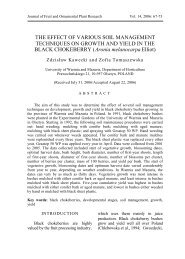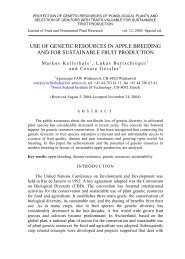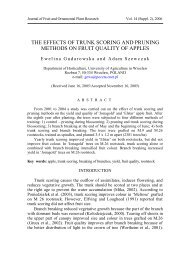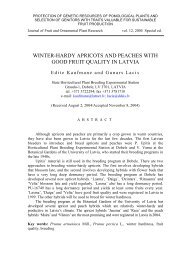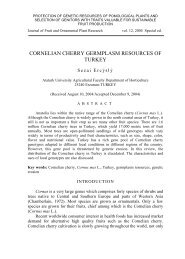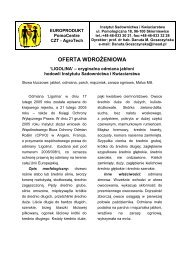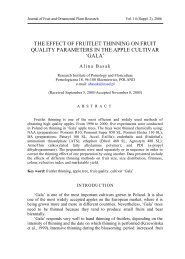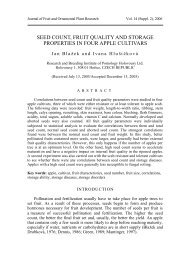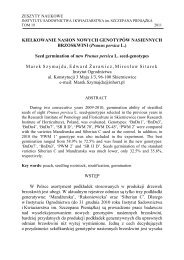MICROCLONAL PROPAGATION OF Vaccinium SP. AND Rubus SP ...
MICROCLONAL PROPAGATION OF Vaccinium SP. AND Rubus SP ...
MICROCLONAL PROPAGATION OF Vaccinium SP. AND Rubus SP ...
Create successful ePaper yourself
Turn your PDF publications into a flip-book with our unique Google optimized e-Paper software.
Microclonal propagation of <strong>Vaccinium</strong> sp. and <strong>Rubus</strong> sp. …buds formed on hypocotyl explants cultured on medium containing 1.0 mg l -1BAP and 0.5 mg l -1 IBA. The best results were obtained with leaf explants of‘Bulharský rubín’ cultured on MS medium containing 0.5 mg l -1 TDZ and 0.2mg l -1 2,4-D. In the blackberry, TDZ has been found to stimulate adventitiousshoot formation better than BAP (Hassan et al., 1993). In some raspberrycultivars, TDZ alone or in combination with IBA effectively inducedadventitious bud formation (Graham et al., 1997). However, when TDZ wasused at higher concentrations or in combination with 2,4-D, shootregeneration was completely inhibited in all cultivars. In our study, TDZ athigher concentrations caused explant necrosis. Therefore, we will use anotherauxin in future experiments.RAPD is a simple and reliable molecular technique that had been used toidentify cultivars and clones and to determine inter-relatedness in manyperennial woody species, including <strong>Vaccinium</strong> species (Persson andGustavsson, 2001; Arce-Johnson et al., 2002). In the bilberry (V. myrtillus),RAPD and AFLP (Amplified Fragment Length Polymorphism) have beentested for their usefulness in clone identification (Albert et al., 2003; 2004).Both RAPD and AFLP yielded the same results, which mean that bothtechniques are reliable.Our results show that RAPD is a reliable technique for identifyingblueberry cultivars. The cultivars tested produced distinct banding patterns.However, we had to screen several primers to find ones which amplified DNAin the cultivars tested. Furthermore, PCR had to be repeated several times inorder to obtain readable banding patterns.In the cranberry (V. macrocarpon), RAPD have been successfully used todistinguish varieties. However, RAPD has some limitations. Several reactionswith several primers are required to reliably identify each clone. Also,artefacts often make accurate identification difficult (Polashock and Vorsa,2002). In the study on the high-bush blueberry, the genetic relations amongthe genotypes tested determined by RAPD analysis did not agree well withknown pedigree data (Levi and Rowland, 1997). In the peach, RAPD has beenused to detect somaclonal variants in regenerated clones (Hashmi et al.,1997).Also in the kiwi fruit, both RAPD and SSR were used to detect somaclonalvariants (Palombi and Damiano, 2002).In our experiments, there were no differences in the DNA profiles of themother plants and any of the clones derived from them by either axillary oradventitious organogenesis. Flow cytometry did not detect any changes in theploidy level of the clones derived from in vitro culture within a single cultivar.We can therefore conclude that more specific techniques have to be usedto detect somaclonal variation in micro-propagated plants. Among thetechniques which should be further investigated are SSR, EST-PCR (Rowlandet al., 2003a; Rowland et al., 2003b).J. Fruit Ornam. Plant Res. vol. 14 (Suppl. 1), 2006: 103-119 115




